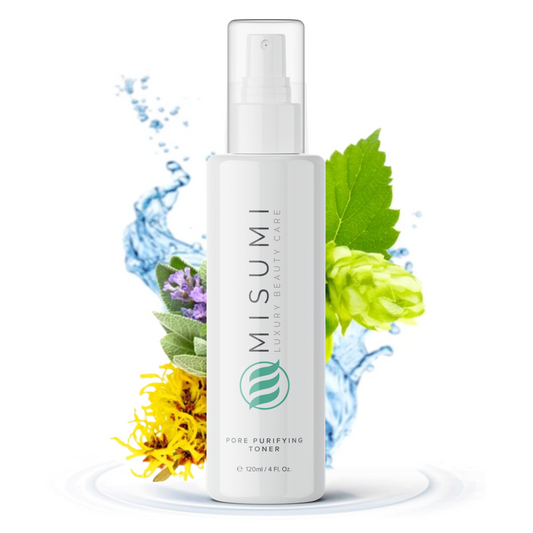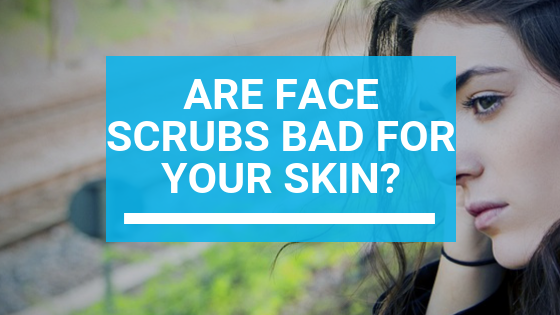We've all heard the good old saying, "moderation is key." When it comes to skincare, the same rules apply. Whatever product or routine we've chosen, overdoing it is never a good idea.
Are you the type of person that exfoliates daily using abrasive methods and products? Then this article is for you. We'll explore all the different types of exfoliation and whether they're actually good for the skin. We'll also provide some alternatives you can use to ensure that you're properly exfoliating your skin regularly.
We'll also let you know which methods you should stay away from completely. So, if you'd like to put an end to all the exfoliating mistakes you might be making, continue reading.
If you want a less abrasive skin care routine, try Misumi's Complete Clear 3-Step System.
Why is Exfoliating Important?

Exfoliation is an extremely important part of an effective skincare regime for various reasons. By exfoliating properly, you're washing away dead skin cells from the skin's surface. On top of that, exfoliation helps us uncover the healthy layer of skin underneath.
Exfoliating can also help with fine lines and wrinkles, leaving your skin looking youthful and dewy.
By exfoliating regularly, the products you use in your skincare routine will be more effective. They'll be able to penetrate deeply into the skin and work better in general.
Types of Exfoliators
Before we give a definite answer to today's topic, it's time to think about the different types of exfoliators on the market and how you can differentiate between them to give your skin the proper treatment it deserves.
There is a general division between exfoliators: physical and chemical.
Physical Exfoliators
Physical exfoliants contain physical ingredients like beads, salt grains, and sugar to remove dead skin cells. Their name explains it all – these harsh ingredients act as exfoliators. The trouble is, sometimes, they can be a little too much on the skin.
You'd be surprised to hear that people use all kinds of ingredients to exfoliate their faces. You don't need us to tell you why that's not the best idea when it comes to your face, especially if you have sensitive skin.

Chemical Exfoliators
Most of the time, chemical exfoliators contain acids that have the same effect as physical exfoliators – they remove dead skin cells from the skin barrier and help the skin reveal a new and healthier layer underneath. But chemical exfoliators are more acidic.
The most commonly used acids to exfoliate are AHAs (Alpha Hydroxy Acids), BHAs (otherwise known as salicylic acid), and lactic acid. The percentage of concentration varies from product to product. This can make chemical exfoliation slightly more complicated and confusing, especially for people new to using a chemical exfoliator.
Why Physical Scrubs Might Not Be a Good Idea
Physical exfoliation scrubs can be dangerous to experiment with for various reasons. Here are the potential complications of including a physical scrub in your skin care regimen.
Physical Scrubs Might Lead to Acne
Sometimes, physical exfoliants are accompanied by rough surfaces such as cloths or special brushes which are designed to deepen the clean and remove dead cells. For anyone who has acne-prone skin or other skin conditions, these methods of exfoliation might not be well suited for your skin type.

The acne-causing bacteria might transfer onto them, causing new breakouts each time you use them. So, if you're in the middle of treating acne, pay attention to whether or not the product you're planning to use requires any kind of equipment. If it does, it might not be the best fit for you.
Want to beat acne? Try Misumi's Clear Skin Duo Kit.
Physical Scrubs Might Lead to Micro-Tears
The term 'micro-tear' might sound terrifying, but it's actually referring to the little tears you can experience by using face scrubs that have large beads like fruit pits.
Harsh face scrubs are known for causing micro-tears in your skin barrier, which can damage it in the long run. To avoid this, make sure the face scrub you've chosen is dermatologically approved and doesn't contain large beads that might permanently scar your face.
Physical Scrubs Might Permanently Damage Your Skin

If you're too aggressive with an abrasive scrub, it might lead to some scary side effects, like permanent skin damage. You can protect your skin from this in two ways: by paying attention to the products you choose and by keeping an eye on how you apply your face scrub.
Don't use aggressive and fast motions when exfoliating. Instead, use gentle motions when using face scrubs, especially physical ones, to avoid irritation.
How to Know if Face Scrubs Will be Damaging to Your Skin?
Yes, face scrubs can be damaging to the skin's barrier and pores. But whether or not they end up being bad will depend largely on the product you've chosen.
How can you tell if a scrub will be damaging? Pay attention to the ingredients. If it contains any kind of shells, pits, or beads, it might not be a good investment. Size matters, people. If the beads look too big to put near your face, that particular scrub will probably cause more damage to your skin than help.
Here's another good tip to use when choosing exfoliators: rub a bit of the scrub on the back of your hand. You can find a tester and try it out in the store. If it feels scratchy and rough, don't buy it.
Generally speaking, when it comes to the delicate skin on our faces, chemical exfoliants take the cake. Physical exfoliants are a good body scrub option, but they're often way too harsh on the face.
How to Use Chemical Exfoliators

Have you decided that you might be the perfect fit for a chemical exfoliant? Great, but there are a few things to keep in mind. Ensuring that you know what to pay attention to will minimize the chances of you suffering from any side effects.
Before using any product or treatment, purchase an SPF product that will protect you from the sun. It should protect from UVA and UVB rays and be at least SPF 30. Sun protection is one of the most important steps in using any type of acid, yet it's so often overlooked. Make sure you make this step a priority.
Whichever product you end up using, a patch test is a must! This is where you try out a product on a small area of your skin and see how it reacts to it before covering your entire face.
Start slow, with a low percentage of the chosen acid. Use the exfoliant up to two times a week. Once enough time has passed, increase the number of times you use the exfoliant. This will help your skin get used to the product.
Still Want to Try Out a Physical Exfoliant?

If we still haven't discouraged you from trying out a physical exfoliant, here are some things to keep in mind for a painless and side-effect-free experience.
First things first, follow the instructions carefully.
Opt for a gentle scrub.
If the product contains abrasive microbeads, pay close attention to the motions you use to exfoliate. More natural exfoliants opt for crushed walnut shells, apricot pits, apricot kernels, jojoba beads, or other nut shells over microbeads.
Being too harsh with your hands can lead to cuts, bleeding, and general damage to the skin. Use gentle circular motions and light pressure when rubbing it onto the skin. Stay away from scrubs containing large beads - these aren't a good idea for anyone. The same rule applies to mechanical exfoliation tools.
Remember, they're not suitable for all skin types. If you have dry skin, go ahead. But if you have sensitive skin or acne-prone skin, leave it out of your skin care routine.
Don’t Overdo It!
The most important rule when using both physical and chemical exfoliants for skin care is not to overdo it. Over-exfoliation comes with all kinds of negative side effects, which can damage your skin in the long run.

A general rule of thumb is to keep your exfoliating practice to once or twice a week. This way, you'll get the exfoliation your skin needs without causing irritation, redness, or even acne.
Another mistake people make is skipping moisturizing. Don't forget to moisturize your skin after you're done with exfoliation, but wait at least a few minutes.
Takeaway
Exfoliation is crucial for healthy skin, but you need to pay attention to the scrubs you use.
Choosing the right exfoliator for your skin type can be overwhelming since there are many to choose from. Broadly speaking, there are two types of exfoliators: chemical and physical. Chemical exfoliants are better and gentler on the skin than physical ones. The type of acid you choose will depend on what kind of skin you have.
Remember, don't overdo it! Otherwise, you're well on your way to healthier and fresher-looking skin.
This information is meant to supplement, not replace advice from your doctor or healthcare provider and is not meant to cover all possible uses, precautions, interactions or adverse effects. This information may not fit your specific health circumstances, and its goal is to offer a general view of the subject. In case you are suffering from a severe case of acne, you should consult with a dermatologist or a certified medical professional.









